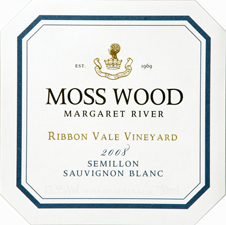Moss Wood Ribbon Vale Vineyard 2008 Semillon Sauvignon Blanc
Moss Wood Ribbon Vale Vineyard 2008 Semillon Sauvignon Blanc

Wine Facts
Blend: Semillon 57%, Sauvignon Blanc 43%
| Yield: | 7.23 t/ha |
| Alcohol: | 13.50% |
| Vintage Rating: | 10/10 |
SOLD OUT
Tasting Notes
Colour and Condition: Medium straw hue, in bright condition.
Nose: A very fresh and zesty combination of gooseberry, leaf, lemon sherbet and grass.
Palate: Lemon, grassy and juicy gooseberry fruit flavours, with medium body and zesty acid, with a long, clean, grapefruit finish, with no phenolics.
[hr]
Vintage Notes
The 2007/2008 growing season provided an interesting contrast between the two varieties, where Sauvignon Blanc appeared to have the best of the conditions. Inclement weather during flowering reduced the Semillon yield to its lowest in 10 years. Its long term average is 11.19 tonnes per hectare but in 2008 it could only manage 7.23 tonnes per hectare, which is still a reasonable crop but quite small by Semillon standards.
On the other hand, the Sauvignon Blanc coped better with the conditions and produced 10.89 tonnes per hectare, which compares favourably with the long term average of 11.19. The timing of the wet and windy conditions obviously didn’t suit the Semillon!
All other aspects of the season went well and both varieties remained free of pest and disease. The bird pressure that was so extreme at the Moss Wood vineyard did not eventuate at Ribbon Vale. The East Block, in particular, is isolated enough that in some years the birds don’t find it but the West Block is often not so lucky. However, the application of nets prevented any problems.
With consistent warm conditions both varieties ripened quickly and evenly and were harvested earlier than average. Sauvignon Blanc came off on the 15th February, some 15 days ahead of average, while the small crop saw the Semillon sail through very quickly. It was picked on the 26th February, well ahead of its average date of the 20th March.
We have now accrued significant experience with Sauvignon Blanc and our understanding of the blended wine style has led us to quite specific harvest requirements. This variety gives the most lifted aromas when picked at a relatively low ripeness, usually around 11.5° Baume and where it retains most of the gooseberry, green characters. At this level, the palate retains very crisp acidity and light to medium body and can lack concentration. It is primarily for this reason that we harvest the Semillon much riper, usually at least 13° Baume. It adds concentration to the palate by improving the mouthfeel and introducing ripe fruit flavours. We proudly note that the 2008 result is about as good as we have been able to achieve so far – the Sauvignon Blanc came in at 11.8° Baume and the Semillon at 13.2° Baume.
[hr]
Production Notes
All fruit was picked by hand and then de-stemmed, drained and pressed, with free run and pressings kept separate. The juices were cold settled then racked and seeded with pure yeast culture for fermentation, which was carried out in stainless steel. We do not use barrels for fermentation or aging because like the Moss Wood Semillon, we want the wine to be a pure expression of fruit. Temperatures were controlled at 15°C for Sauvignon Blanc and 17°C for Semillon.
At the completion of ferment each batch was racked off gross lees and the two varieties were blended. The finished wine was then fined for tannins and protein stability and then sterile filtered and bottled on the 28th May, 2008. For wines in this style we believe fresh, bright aromas are essential and so we bottle the Semillon Sauvignon Blanc as quickly as possible after vintage.
[hr]
Cellaring Notes
Since most consumers of this style enjoy it for its vibrant fruit characters, a very large percentage of the Semillon Sauvignon Blanc is drunk within a year of its release. At the same time, the style should not be written off as one that will not reward cellaring and we note that Semillon Sauvignon Blanc blends from the Bordeaux region in France have a proud history of long term cellaring.
Customers who prefer to see this style with some bottle development can cellar it with confidence. It will retain strong primary fruit aromas until 2 years old, after which there will be a gradual loss of freshness. Over a further 3 to 5 years the wine will develop its bottle bouquet consisting of toast and marmalade notes and should drink best as a complex wine at around 10 years of age.
